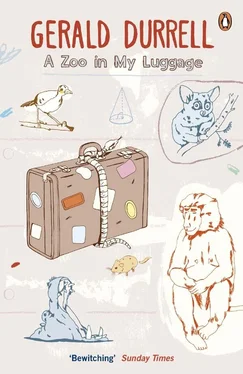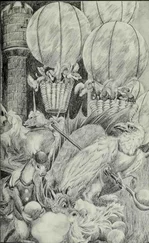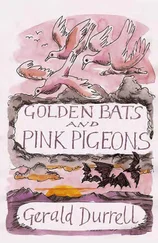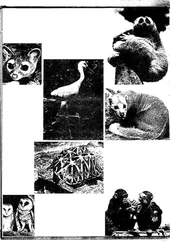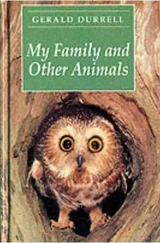Gerald Durrell - A Zoo in My Luggage
Здесь есть возможность читать онлайн «Gerald Durrell - A Zoo in My Luggage» весь текст электронной книги совершенно бесплатно (целиком полную версию без сокращений). В некоторых случаях можно слушать аудио, скачать через торрент в формате fb2 и присутствует краткое содержание. Жанр: Природа и животные, на английском языке. Описание произведения, (предисловие) а так же отзывы посетителей доступны на портале библиотеки ЛибКат.
- Название:A Zoo in My Luggage
- Автор:
- Жанр:
- Год:неизвестен
- ISBN:нет данных
- Рейтинг книги:4 / 5. Голосов: 1
-
Избранное:Добавить в избранное
- Отзывы:
-
Ваша оценка:
- 80
- 1
- 2
- 3
- 4
- 5
A Zoo in My Luggage: краткое содержание, описание и аннотация
Предлагаем к чтению аннотацию, описание, краткое содержание или предисловие (зависит от того, что написал сам автор книги «A Zoo in My Luggage»). Если вы не нашли необходимую информацию о книге — напишите в комментариях, мы постараемся отыскать её.
A Zoo in My Luggage — читать онлайн бесплатно полную книгу (весь текст) целиком
Ниже представлен текст книги, разбитый по страницам. Система сохранения места последней прочитанной страницы, позволяет с удобством читать онлайн бесплатно книгу «A Zoo in My Luggage», без необходимости каждый раз заново искать на чём Вы остановились. Поставьте закладку, и сможете в любой момент перейти на страницу, на которой закончили чтение.
Интервал:
Закладка:
‘Na whatee dat?’ I whispered.
‘Na de bird, sah.’
The first cry had been quite far down the hill, but now came another cry, much closer. It was a curious noise which can only be described, rather inadequately, as similar to the sudden sharp yap of a pekinese, but much more flute-like and plaintive. Again it came, and again, but we still could not see the bird, though we strained our eyes in the gloom.
‘D’you think it’s Picathartes ?’ whispered Bob.
‘I don’t know … It’s a noise I haven’t heard before.’
There was a pause, and then suddenly the cry was repeated, very near now, and we lay motionless behind our rock. Not far in front of our position grew a thirty-foot sapling, bent under the weight of a liana as thick as a bell-rope that hung in loops around it, its main stem hidden in the foliage of some near-by tree. While the rest of the area we could see was gloomy and ill-defined, this sapling, lovingly entwined by its killer liana, was lit by the last rays of the setting sun, so that the whole setting was rather like a meticulous backcloth. And, as though a curtain had gone up on this miniature stage, a real live Picathartes suddenly appeared before us.
I say suddenly and I mean it. Animals and birds in a tropical forest generally approach so quietly that they appear before you suddenly, unexpectedly, as if dropped there by magic. The thick liana fell in a huge loop from the top of the sapling, and on this loop the bird materialized, swaying gently on its perch, its head cocked on one side as if listening. Seeing any wild animal in its natural surroundings is a thrill, but to watch something that you know is a great rarity, something that you know has only been seen by a handful of people before you, gives the whole thing an added excitement and spice. So Bob and I lay there staring at the bird with the ardent, avid expressions of a couple of philatelists who have just discovered a penny black in a child’s stamp album.
The Picathartes was about the size of a jackdaw, but its body had the plump, sleek lines of a blackbird. Its legs were long and powerful, and its eyes large and obviously keen. The breast was a delicate creamy-buff and the back and long tail a beautiful slate grey, pale and powdery-looking. The edge of the wing was black and this acted as a dividing-line that showed up wonderfully the breast and back colours. But it was the bird’s head that caught the attention and held it. It was completely bare of feathers: the forehead and top of the head were a vivid sky blue, the back a bright rose-madder pink, while the sides of the head and the cheeks were black. Normally a bald-headed bird looks rather revolting, as if it were suffering from some unpleasant and incurable disease, but Picathartes looked splendid with its tricoloured head, as if wearing a crown.
After the bird had perched on the liana for a minute or so it flew down on to the ground, and proceeded to work its way to and fro among the rocks in a series of prodigious leaps, quite extraordinary to watch. They were not ordinary bird-like hops, for Picathartes was projected into the air as if those powerful legs were springs. It disappeared from view among the rocks, and we heard it call. It was answered almost at once from the top of the cliff, and looking up we could see another Picathartes on a branch above us, peering down at the nests on the cliff face. Suddenly it spiralled downwards and alighted on the edge of one of the nests, paused a moment to look about, and then leaned forward to tidy up a hair-like rootlet that had become disarranged. Then the bird leaped into the air – there was no other way to describe it – and swooped down the hill into the gloomy forest. The other emerged from among the rocks and flew after it, and in a short time we heard them calling to each other plaintively among the trees.
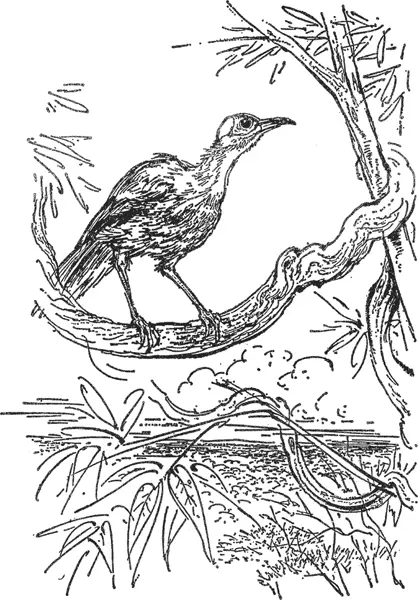
‘Ah,’ said Elias, rising and stretching himself, ‘’e done go.’
‘’E no go come back?’ I asked, pummelling my leg, which had gone to sleep.
‘No, sah. ’E done go for inside bush, for some big stick where ’e go sleep. Tomorrow ’e go come back for work dis ’e house.’
‘Well, we might as well go back to Eshobi then.’
Our progress down the hill was a much speedier affair than our ascent. It was now so dark under the canopy of trees that we frequently missed our footing and slid for considerable distances on our backsides, clutching desperately at trees and roots as we passed in an effort to slow down. Eventually we emerged in the Eshobi high street bruised, scratched and covered with leaf mould. I was filled with elation at having seen a live Picathartes , but, at the same time, depressed by the thought that we could not hope to get any of the youngsters. It was obviously useless hanging around in Eshobi, so I decided we would set off again for Mamfe the next day, and try to do a little collecting as we passed through the forest. One of the most successful ways of collecting animals in the Cameroons is to smoke out hollow trees, and on our way to Eshobi I had noticed several huge trees with hollow insides, which I thought might well repay investigation.
Early the next morning we packed up our equipment, and sent the carriers off with it. Then, accompanied by Elias and three other Eshobi hunters, Bob and I followed at a more leisurely pace.
The first tree was three miles into the forest, lying fairly close to the edge of the Eshobi road. It was a hundred and fifty feet high, and the greater part of its trunk was as hollow as a drum. There is quite an art to smoking out a hollow tree. It is a prolonged and sometimes complicated process. Before going to all the trouble of smoking a tree the first thing to do, if possible, is to ascertain whether or not there is anything inside worth smoking out. If the tree has a large hole at the base of the trunk, as most of them do, this is a relatively simple matter. You simply stick your head inside and get somebody to beat the trunk with a stick. If there are any animals inside you will hear them moving about uneasily after the reverberations have died away, and even if you can’t hear them you can be assured of their presence by the shower of powdery rotten wood that will come cascading down the trunk. Having discovered that there is something inside the tree the next job is to scan the top part of the trunk with field-glasses and try and spot all exit holes, which then have to be covered with nets. When this has been done, a man is stationed up the tree to retrieve any creature that gets caught up there, the holes at the base of the trunk are stopped. You then light a fire, and this is the really tricky part of the operation, for the inside of these trees is generally dry and tinder-like, and if you are not careful you can set the whole thing ablaze. So first of all you kindle a small bright blaze with dry twigs, moss and leaves, and when this is well alight you carefully cover it with ever-increasing quantities of green leaves, so that the fire no longer blazes but sends up a sullen column of pungent smoke, which is sucked up the hollow barrel of the tree exactly as if it were a chimney. After this anything can happen and generally does, for these hollow trees often contain a weird variety of inhabitants, ranging from spitting cobras to civet cats, from bats to giant snails; half the charm and excitement of smoking out a tree is that you are never quite sure what is going to appear next.
The first tree we smoked was not a wild success. All we got was a handful of leaf-nosed bats with extraordinary gargoyle-like faces, three giant millipedes that looked like Frankfurter sausages with a fringe of legs underneath and a small grey dormouse which bit one of the hunters in the thumb and escaped. So we removed the nets, put out the fire and proceeded on our way. The next hollow tree was considerably taller and of tremendous girth. At its base was an enormous split in the trunk shaped like a church door, and four of us could stand comfortably in the gloomy interior of the trunk. Peering up the hollow barrel of the trunk and beating on the wood with a machete we were rewarded by vague scuffling noises from above, and a shower of powdery rotten wood fell on our upturned faces and into our eyes. Obviously the tree contained something. Our chief problem was to get a hunter to the top of the tree to cover the exit holes, for the trunk swept up about a hundred and twenty feet into the sky as smooth as a walking-stick. Eventually, we joined all three of our rope-ladders together, and tied a strong, light rope to one end. Then, weighting the rope end, we hurled it up and into the forest canopy until our arms ached, until at last it fell over a branch and we could haul the ladders up into the sky and secure them. So, when the nets were fixed in position at the top and bottom of the tree, we lit the fire at the base of the trunk and stood back to await results.
Читать дальшеИнтервал:
Закладка:
Похожие книги на «A Zoo in My Luggage»
Представляем Вашему вниманию похожие книги на «A Zoo in My Luggage» списком для выбора. Мы отобрали схожую по названию и смыслу литературу в надежде предоставить читателям больше вариантов отыскать новые, интересные, ещё непрочитанные произведения.
Обсуждение, отзывы о книге «A Zoo in My Luggage» и просто собственные мнения читателей. Оставьте ваши комментарии, напишите, что Вы думаете о произведении, его смысле или главных героях. Укажите что конкретно понравилось, а что нет, и почему Вы так считаете.
